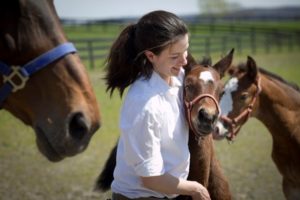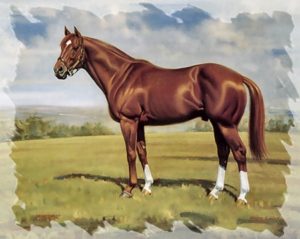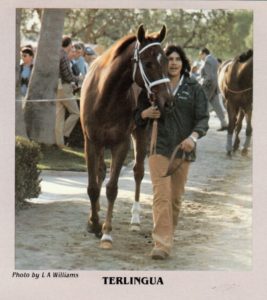By Jenny L. Sones, DVM, PhD, DACT.
For many years horsemen and women have witnessed a phenomenon known as the Maternal Grandsire Effect. The most notable example of this being Secretariat (Figure 1), one of the greatest Thoroughbred racehorses of our time. While Secretariat was one of the most impressive athletes of modern times, his offspring did not race to his competitive level.
Figure 1. Secretariat, one of the most impressive athletes of modern times and his daughters were exceptional broodmares. (Anthony Alonso, http://www.eleganthorsepictures.com/smith-secretariat.html)
However, his daughters were exceptional broodmares, one notable daughter being Terlingua (Figure 2). Not only was she a record breaking stakes winner herself, but she was also the dame of two-time leading North American sire, Storm Cat.
Figure 2. Terlingua, notable daughter of Secretariat. (https://thevaulthorseracing.wordpress.com/2011/06/04/following-terlingua/)
In recent years, veterinary scientists have begun to shed light on the genetic mechanisms that lead to the Maternal Grandsire Effect. Important studies in the 1960s revealed that the stallion’s role in breeding does not stop at conception, but continues to ensure pregnancy maintenance in the mare. Scientists measured equine chorionic gonadotropin (eCG), the placenta-derived hormone of pregnancy maintenance in the horse, in horse x horse and donkey x donkey pregnancies. While eCG is high in horse x horse pregnancies, it is low in donkey x donkey pregnancies. Interestingly, crossing a mare and a jack (male donkey) results in low eCG, but when a jenny (female donkey) is crossed to a stallion eCG is high, similar to that seen in horse x horse pregnancies. This crucial finding pointed those in the field to investigate the role of the stallion’s genetics in pregnancy success.
Equine geneticists combined these previous findings with the novel discovery of offspring genes in which expression is exclusively derived from maternally (dam) or paternally (sire) inherited genes, but not both. These genes, known as imprinted genes, are present in the placenta. Nearly 50 years after the eCG experiments, scientists uncovered that nearly 100% of imprinted genes in the placenta are paternally expressed, i.e. a result of the sire’s DNA sequence being passed down. Therefore, the stallion plays a central role not only in conception, but also in the maintenance of pregnancy through placental gene expression and thus health of the foal. In the last 10 years, leading scientists have also determined the “speed gene” that is believed to contribute to racing success in Thoroughbred horses. With the rapid pace of science and technology, the breeding industry will likely add parental genetics to determine the best crosses for creating the ideal racehorse that carries the “speed gene” from the sire or dam. The Maternal Grandsire Effect has been proven to be beyond an observation, instead becoming the prelude to a scientific breakthrough that has longstanding implications for horse breeding and beyond.
Jenny L. Sones is Assistant Professor of Theriogenology (Reproductive Medicine) in the Equine Health Studies Program in the Department of Veterinary Clinical Sciences, Louisiana State University, Veterinary Teaching Hospita, Baton Rouge, LA.








